Shuai Bai
Qwen2.5-Omni Technical Report
Mar 26, 2025Abstract:In this report, we present Qwen2.5-Omni, an end-to-end multimodal model designed to perceive diverse modalities, including text, images, audio, and video, while simultaneously generating text and natural speech responses in a streaming manner. To enable the streaming of multimodal information inputs, both audio and visual encoders utilize a block-wise processing approach. To synchronize the timestamps of video inputs with audio, we organize the audio and video sequentially in an interleaved manner and propose a novel position embedding approach, named TMRoPE(Time-aligned Multimodal RoPE). To concurrently generate text and speech while avoiding interference between the two modalities, we propose \textbf{Thinker-Talker} architecture. In this framework, Thinker functions as a large language model tasked with text generation, while Talker is a dual-track autoregressive model that directly utilizes the hidden representations from the Thinker to produce audio tokens as output. Both the Thinker and Talker models are designed to be trained and inferred in an end-to-end manner. For decoding audio tokens in a streaming manner, we introduce a sliding-window DiT that restricts the receptive field, aiming to reduce the initial package delay. Qwen2.5-Omni is comparable with the similarly sized Qwen2.5-VL and outperforms Qwen2-Audio. Furthermore, Qwen2.5-Omni achieves state-of-the-art performance on multimodal benchmarks like Omni-Bench. Notably, Qwen2.5-Omni's performance in end-to-end speech instruction following is comparable to its capabilities with text inputs, as evidenced by benchmarks such as MMLU and GSM8K. As for speech generation, Qwen2.5-Omni's streaming Talker outperforms most existing streaming and non-streaming alternatives in robustness and naturalness.
Multimodal Representation Alignment for Image Generation: Text-Image Interleaved Control Is Easier Than You Think
Feb 27, 2025Abstract:The field of advanced text-to-image generation is witnessing the emergence of unified frameworks that integrate powerful text encoders, such as CLIP and T5, with Diffusion Transformer backbones. Although there have been efforts to control output images with additional conditions, like canny and depth map, a comprehensive framework for arbitrary text-image interleaved control is still lacking. This gap is especially evident when attempting to merge concepts or visual elements from multiple images in the generation process. To mitigate the gap, we conducted preliminary experiments showing that large multimodal models (LMMs) offer an effective shared representation space, where image and text can be well-aligned to serve as a condition for external diffusion models. Based on this discovery, we propose Dream Engine, an efficient and unified framework designed for arbitrary text-image interleaved control in image generation models. Building on powerful text-to-image models like SD3.5, we replace the original text-only encoders by incorporating versatile multimodal information encoders such as QwenVL. Our approach utilizes a two-stage training paradigm, consisting of joint text-image alignment and multimodal interleaved instruction tuning. Our experiments demonstrate that this training method is effective, achieving a 0.69 overall score on the GenEval benchmark, and matching the performance of state-of-the-art text-to-image models like SD3.5 and FLUX.
Qwen2.5-VL Technical Report
Feb 19, 2025Abstract:We introduce Qwen2.5-VL, the latest flagship model of Qwen vision-language series, which demonstrates significant advancements in both foundational capabilities and innovative functionalities. Qwen2.5-VL achieves a major leap forward in understanding and interacting with the world through enhanced visual recognition, precise object localization, robust document parsing, and long-video comprehension. A standout feature of Qwen2.5-VL is its ability to localize objects using bounding boxes or points accurately. It provides robust structured data extraction from invoices, forms, and tables, as well as detailed analysis of charts, diagrams, and layouts. To handle complex inputs, Qwen2.5-VL introduces dynamic resolution processing and absolute time encoding, enabling it to process images of varying sizes and videos of extended durations (up to hours) with second-level event localization. This allows the model to natively perceive spatial scales and temporal dynamics without relying on traditional normalization techniques. By training a native dynamic-resolution Vision Transformer (ViT) from scratch and incorporating Window Attention, we reduce computational overhead while maintaining native resolution. As a result, Qwen2.5-VL excels not only in static image and document understanding but also as an interactive visual agent capable of reasoning, tool usage, and task execution in real-world scenarios such as operating computers and mobile devices. Qwen2.5-VL is available in three sizes, addressing diverse use cases from edge AI to high-performance computing. The flagship Qwen2.5-VL-72B model matches state-of-the-art models like GPT-4o and Claude 3.5 Sonnet, particularly excelling in document and diagram understanding. Additionally, Qwen2.5-VL maintains robust linguistic performance, preserving the core language competencies of the Qwen2.5 LLM.
Next Token Prediction Towards Multimodal Intelligence: A Comprehensive Survey
Dec 30, 2024



Abstract:Building on the foundations of language modeling in natural language processing, Next Token Prediction (NTP) has evolved into a versatile training objective for machine learning tasks across various modalities, achieving considerable success. As Large Language Models (LLMs) have advanced to unify understanding and generation tasks within the textual modality, recent research has shown that tasks from different modalities can also be effectively encapsulated within the NTP framework, transforming the multimodal information into tokens and predict the next one given the context. This survey introduces a comprehensive taxonomy that unifies both understanding and generation within multimodal learning through the lens of NTP. The proposed taxonomy covers five key aspects: Multimodal tokenization, MMNTP model architectures, unified task representation, datasets \& evaluation, and open challenges. This new taxonomy aims to aid researchers in their exploration of multimodal intelligence. An associated GitHub repository collecting the latest papers and repos is available at https://github.com/LMM101/Awesome-Multimodal-Next-Token-Prediction
CC-OCR: A Comprehensive and Challenging OCR Benchmark for Evaluating Large Multimodal Models in Literacy
Dec 03, 2024Abstract:Large Multimodal Models (LMMs) have demonstrated impressive performance on recognizing document images with natural language instructions. However, it remains unclear to what extent capabilities in literacy with rich structure and fine-grained visual challenges. The current landscape lacks a comprehensive benchmark to effectively measure the literate capabilities of LMMs. Existing benchmarks are often limited by narrow scenarios and specified tasks. To this end, we introduce CC-OCR, a comprehensive benchmark that possess a diverse range of scenarios, tasks, and challenges. CC-OCR comprises four OCR-centric tracks: multi-scene text reading, multilingual text reading, document parsing, and key information extraction. It includes 39 subsets with 7,058 full annotated images, of which 41% are sourced from real applications, being released for the first time. Furthermore, we evaluate nine prominent LMMs and reveal both the strengths and weaknesses of these models, particularly in text grounding, multi-orientation, and hallucination of repetition. CC-OCR aims to comprehensively evaluate the capabilities of LMMs on OCR-centered tasks, driving advancement in LMMs.
Qwen2-VL: Enhancing Vision-Language Model's Perception of the World at Any Resolution
Sep 18, 2024



Abstract:We present the Qwen2-VL Series, an advanced upgrade of the previous Qwen-VL models that redefines the conventional predetermined-resolution approach in visual processing. Qwen2-VL introduces the Naive Dynamic Resolution mechanism, which enables the model to dynamically process images of varying resolutions into different numbers of visual tokens. This approach allows the model to generate more efficient and accurate visual representations, closely aligning with human perceptual processes. The model also integrates Multimodal Rotary Position Embedding (M-RoPE), facilitating the effective fusion of positional information across text, images, and videos. We employ a unified paradigm for processing both images and videos, enhancing the model's visual perception capabilities. To explore the potential of large multimodal models, Qwen2-VL investigates the scaling laws for large vision-language models (LVLMs). By scaling both the model size-with versions at 2B, 8B, and 72B parameters-and the amount of training data, the Qwen2-VL Series achieves highly competitive performance. Notably, the Qwen2-VL-72B model achieves results comparable to leading models such as GPT-4o and Claude3.5-Sonnet across various multimodal benchmarks, outperforming other generalist models. Code is available at \url{https://github.com/QwenLM/Qwen2-VL}.
Qwen2 Technical Report
Jul 16, 2024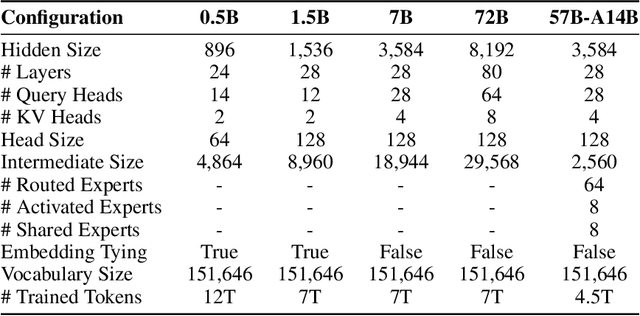
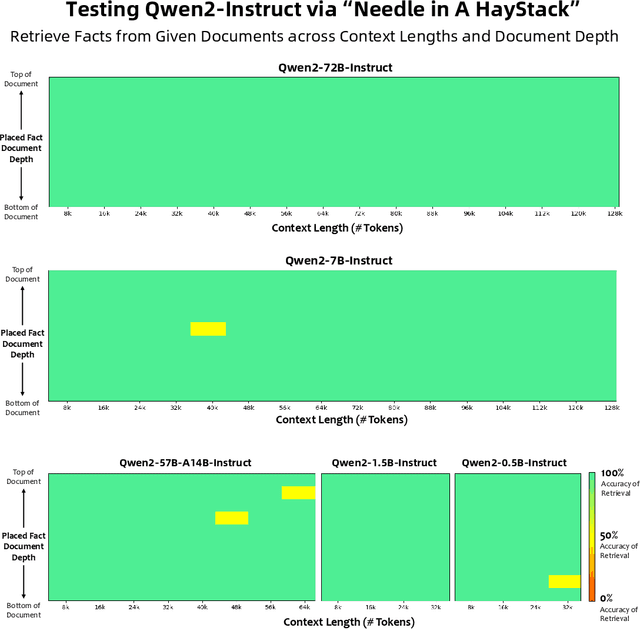
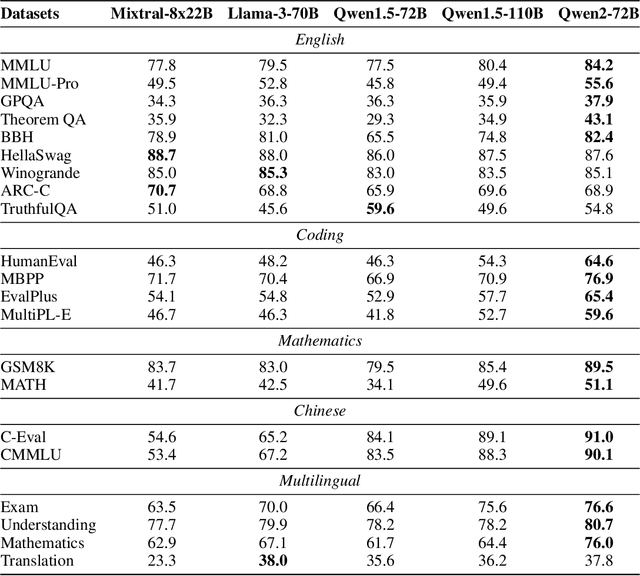
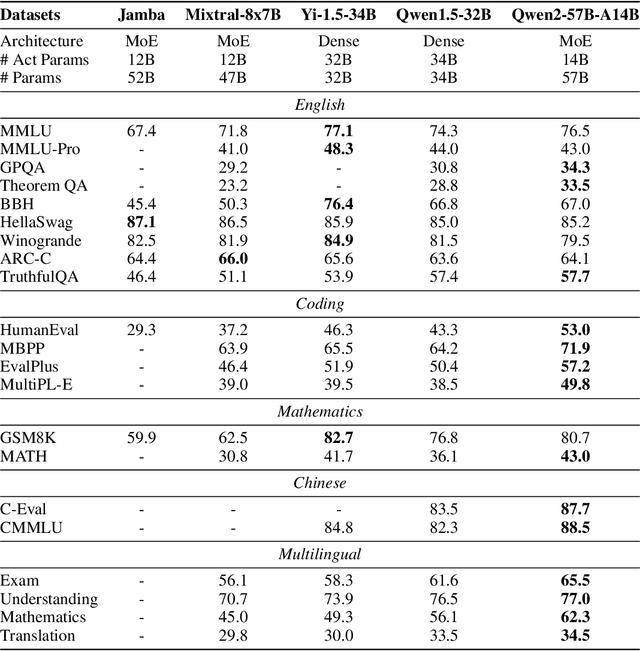
Abstract:This report introduces the Qwen2 series, the latest addition to our large language models and large multimodal models. We release a comprehensive suite of foundational and instruction-tuned language models, encompassing a parameter range from 0.5 to 72 billion, featuring dense models and a Mixture-of-Experts model. Qwen2 surpasses most prior open-weight models, including its predecessor Qwen1.5, and exhibits competitive performance relative to proprietary models across diverse benchmarks on language understanding, generation, multilingual proficiency, coding, mathematics, and reasoning. The flagship model, Qwen2-72B, showcases remarkable performance: 84.2 on MMLU, 37.9 on GPQA, 64.6 on HumanEval, 89.5 on GSM8K, and 82.4 on BBH as a base language model. The instruction-tuned variant, Qwen2-72B-Instruct, attains 9.1 on MT-Bench, 48.1 on Arena-Hard, and 35.7 on LiveCodeBench. Moreover, Qwen2 demonstrates robust multilingual capabilities, proficient in approximately 30 languages, spanning English, Chinese, Spanish, French, German, Arabic, Russian, Korean, Japanese, Thai, Vietnamese, and more, underscoring its versatility and global reach. To foster community innovation and accessibility, we have made the Qwen2 model weights openly available on Hugging Face and ModelScope, and the supplementary materials including example code on GitHub. These platforms also include resources for quantization, fine-tuning, and deployment, facilitating a wide range of applications and research endeavors.
An Image is Worth 1/2 Tokens After Layer 2: Plug-and-Play Inference Acceleration for Large Vision-Language Models
Mar 11, 2024Abstract:In this study, we identify the inefficient attention phenomena in Large Vision-Language Models (LVLMs), notably within prominent models like LLaVA-1.5, QwenVL-Chat and Video-LLaVA. We find out that the attention computation over visual tokens is of extreme inefficiency in the deep layers of popular LVLMs, suggesting a need for a sparser approach compared to textual data handling. To this end, we introduce FastV, a versatile plug-and-play method designed to optimize computational efficiency by learning adaptive attention patterns in early layers and pruning visual tokens in subsequent ones. Our evaluations demonstrate FastV's ability to dramatically reduce computational costs (e.g., a 45 reduction in FLOPs for LLaVA-1.5-13B) without sacrificing performance in a wide range of image and video understanding tasks. The computational efficiency and performance trade-off of FastV are highly customizable and pareto-efficient. It can compress the FLOPs of a 13B-parameter model to achieve a lower budget than that of a 7B-parameter model, while still maintaining superior performance. We believe FastV has practical values for deployment of LVLMs in edge devices and commercial models. Code is released at https://github.com/pkunlp-icler/FastV.
GD^2-NeRF: Generative Detail Compensation via GAN and Diffusion for One-shot Generalizable Neural Radiance Fields
Jan 02, 2024Abstract:In this paper, we focus on the One-shot Novel View Synthesis (O-NVS) task which targets synthesizing photo-realistic novel views given only one reference image per scene. Previous One-shot Generalizable Neural Radiance Fields (OG-NeRF) methods solve this task in an inference-time finetuning-free manner, yet suffer the blurry issue due to the encoder-only architecture that highly relies on the limited reference image. On the other hand, recent diffusion-based image-to-3d methods show vivid plausible results via distilling pre-trained 2D diffusion models into a 3D representation, yet require tedious per-scene optimization. Targeting these issues, we propose the GD$^2$-NeRF, a Generative Detail compensation framework via GAN and Diffusion that is both inference-time finetuning-free and with vivid plausible details. In detail, following a coarse-to-fine strategy, GD$^2$-NeRF is mainly composed of a One-stage Parallel Pipeline (OPP) and a 3D-consistent Detail Enhancer (Diff3DE). At the coarse stage, OPP first efficiently inserts the GAN model into the existing OG-NeRF pipeline for primarily relieving the blurry issue with in-distribution priors captured from the training dataset, achieving a good balance between sharpness (LPIPS, FID) and fidelity (PSNR, SSIM). Then, at the fine stage, Diff3DE further leverages the pre-trained image diffusion models to complement rich out-distribution details while maintaining decent 3D consistency. Extensive experiments on both the synthetic and real-world datasets show that GD$^2$-NeRF noticeably improves the details while without per-scene finetuning.
Qwen Technical Report
Sep 28, 2023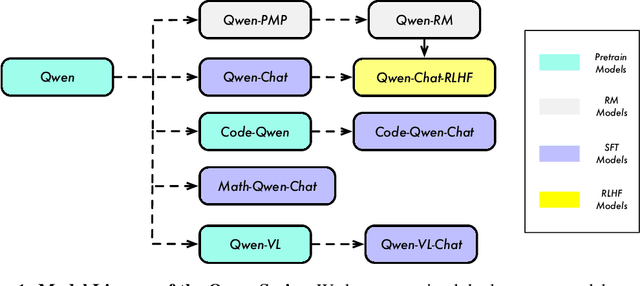

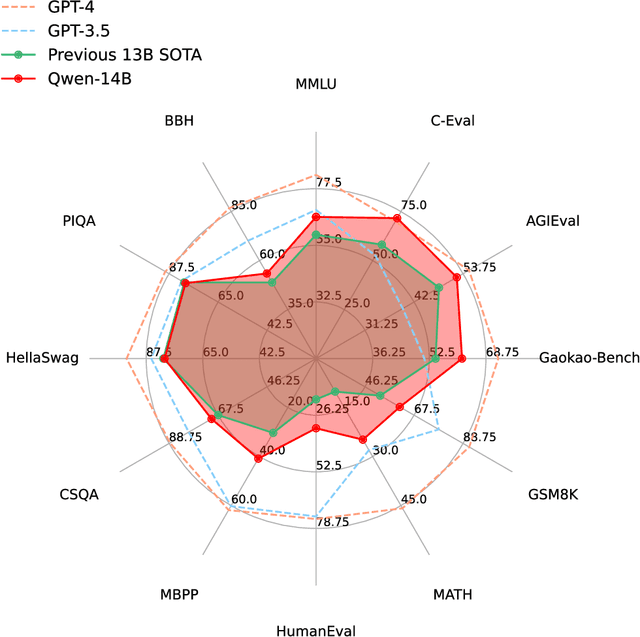
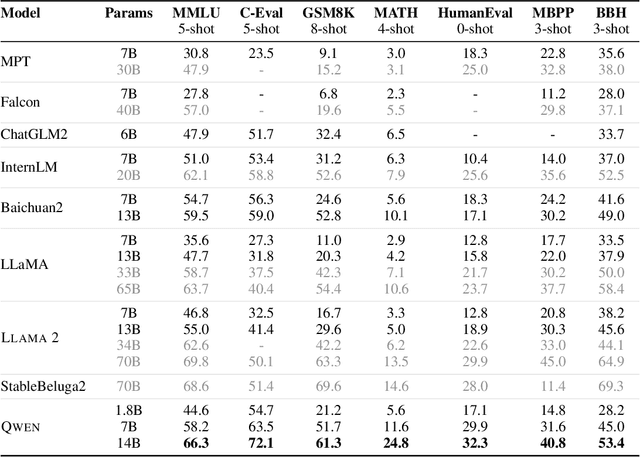
Abstract:Large language models (LLMs) have revolutionized the field of artificial intelligence, enabling natural language processing tasks that were previously thought to be exclusive to humans. In this work, we introduce Qwen, the first installment of our large language model series. Qwen is a comprehensive language model series that encompasses distinct models with varying parameter counts. It includes Qwen, the base pretrained language models, and Qwen-Chat, the chat models finetuned with human alignment techniques. The base language models consistently demonstrate superior performance across a multitude of downstream tasks, and the chat models, particularly those trained using Reinforcement Learning from Human Feedback (RLHF), are highly competitive. The chat models possess advanced tool-use and planning capabilities for creating agent applications, showcasing impressive performance even when compared to bigger models on complex tasks like utilizing a code interpreter. Furthermore, we have developed coding-specialized models, Code-Qwen and Code-Qwen-Chat, as well as mathematics-focused models, Math-Qwen-Chat, which are built upon base language models. These models demonstrate significantly improved performance in comparison with open-source models, and slightly fall behind the proprietary models.
 Add to Chrome
Add to Chrome Add to Firefox
Add to Firefox Add to Edge
Add to Edge